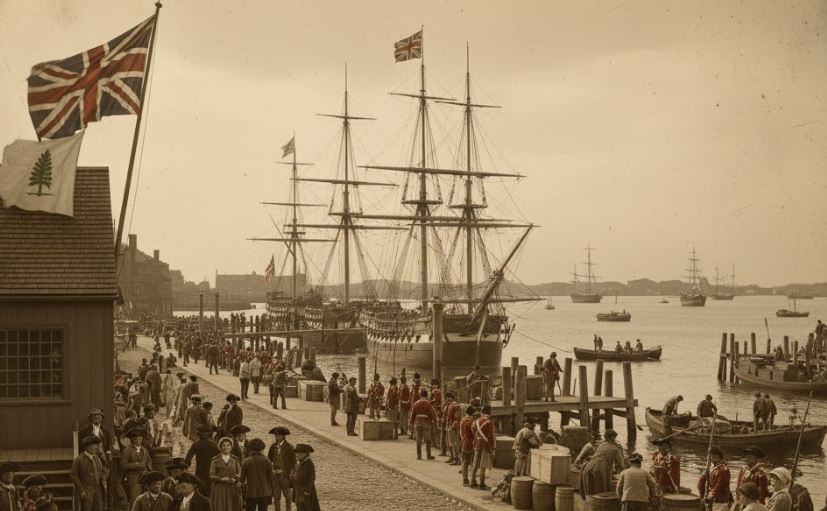Let's explore the names and historical developments that shaped Massachusetts before its statehood.
The Home of the Massachusett and Other Tribes
For thousands of years prior to European arrival, the region that would become Massachusetts was the ancestral homeland of several Algonquian-speaking Native American tribes.
The most prominent, and the one from whom the state derives its name, was the Massachusett tribe. Their name is believed to mean "at the great hill," referring to the Great Blue Hill in Milton, south of Boston. Other significant tribes included the Wampanoag (famous for their interactions with the Pilgrims), the Nipmuc, the Pennacook, and the Nauset. These communities lived in settled villages, practiced agriculture, hunted, and fished, thriving along the coasts and river valleys.
Early English Attempts: "New England" and "Northern Virginia"
Before successful permanent settlements, English explorers and colonizers vaguely referred to the entire northeastern coast of North America as "New England." Captain John Smith, who mapped the coast in 1614, coined the term and published a detailed map of the area.
Interestingly, early English royal charters often bundled this region with more southern claims. For example, the land was sometimes considered part of "Northern Virginia" in the charters granted to the Virginia Company, reflecting the imprecise understanding of North American geography at the time.
The Twin Pillars: Plymouth Colony and Massachusetts Bay Colony
The story of pre-state Massachusetts is largely the story of two distinct, yet ultimately merging, English colonies:
-
Plymouth Colony (1620-1691): Established by the Pilgrims, who arrived on the Mayflower, this was the first permanent European settlement in New England. They landed at what they named Plymouth (after the port in England from which they departed). This small, independent colony was known for its Mayflower Compact, its interactions with the Wampanoag, and its strict Separatist religious principles.
-
Massachusetts Bay Colony (1628-1691): Founded by Puritan nonconformists seeking religious freedom (though not necessarily for others), this colony quickly grew to become the largest and most influential in New England. Its main settlement was Boston, and its founders envisioned it as a "City upon a Hill"—a model of a godly commonwealth. The colony's charter directly referred to it as the "Colony of the Massachusetts Bay in New England."
These two colonies, though culturally similar, operated as separate political entities for over 70 years, each with its own governor and laws.
The Dominion of New England (1686-1689)
During a period of increased royal control over the colonies, King James II attempted to consolidate all the New England colonies (and eventually New York and New Jersey) into a single, large administrative unit called the Dominion of New England. This was a brief, unpopular, and ultimately unsuccessful attempt to strip the colonies of their self-governance. It was dissolved shortly after the Glorious Revolution in England.
The Province of Massachusetts Bay (1691-1776)
The most direct predecessor to the modern state was the Province of Massachusetts Bay. This larger, unified royal colony was created by a new charter from William and Mary in 1691. This charter formally merged:
- Plymouth Colony
- Massachusetts Bay Colony
- The Province of Maine
- Nova Scotia (for a time)
- Martha's Vineyard and Nantucket
This consolidated entity, officially known as "The Province of Massachusetts Bay," greatly expanded the territory and formalized royal control, appointing a governor rather than allowing the colonists to elect their own. It was under this name that Massachusetts played a central role in the growing friction with Great Britain, leading up to the American Revolution.
Commonwealth and Statehood
 Following the outbreak of the American Revolution in 1775, the Province of Massachusetts Bay effectively became an independent entity. In 1780, it adopted its own constitution, formally declaring itself the "Commonwealth of Massachusetts." The term "Commonwealth" (also used by Virginia, Pennsylvania, and Kentucky) was chosen to emphasize that the new government was based on the consent of the people for the "common good."
Following the outbreak of the American Revolution in 1775, the Province of Massachusetts Bay effectively became an independent entity. In 1780, it adopted its own constitution, formally declaring itself the "Commonwealth of Massachusetts." The term "Commonwealth" (also used by Virginia, Pennsylvania, and Kentucky) was chosen to emphasize that the new government was based on the consent of the people for the "common good."
On February 6, 1788, Massachusetts proudly ratified the United States Constitution, becoming the sixth state to join the newly formed nation. The name "Massachusetts," rooted in its indigenous past, has continued ever since.
